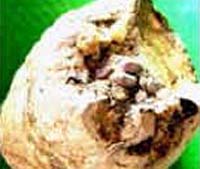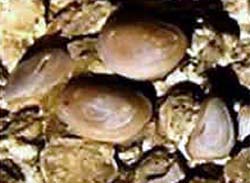Dec 25, 2025
Dec 25, 2025
After death the plant decays over a period of time but phytoliths do not decay, that is why they are easily discernible in fossils of teeth and poop. Phytoliths are the key to past environments. Apart from Phytoliths the Dino poop from Pisdura contains seeds, some showing signs of partial digestion! Along with seed Debi Dutt and Ambawani found some black, probably organic matter which they suspect to be the remains of the fruit pulp that contained the seeds! The process of digestion is difficult to study even in the living herbivores. It is more of a conjecture in case of fossil animals and in case of extinct animals it is almost a guess based on circumstantial evidence. The authors suspect that the grass, fruits and other matter were digested and whatever could not be digested, probably being harder was passed out in the feces. It is now preserved with fossil poop. No doubt the title is stinky, but two young scientists from Lucknow have been able to break the secrets of what the dinosaurs ate from their excreta-coprolites. Debi Dutta from the Department of geology and K. Ambwani from the Department of Botany while searching for coprolites at Pisdura, in Warora district Maharashtra found a number of 'deposits'. From the concentration of coprolites or the fossils of excreta it appears that the dinosaurs were abundant in this region and were exclusively vegetarian.
No doubt the title is stinky, but two young scientists from Lucknow have been able to break the secrets of what the dinosaurs ate from their excreta-coprolites. Debi Dutta from the Department of geology and K. Ambwani from the Department of Botany while searching for coprolites at Pisdura, in Warora district Maharashtra found a number of 'deposits'. From the concentration of coprolites or the fossils of excreta it appears that the dinosaurs were abundant in this region and were exclusively vegetarian.
It is amazing to know that the fossils of dino excreta have distinct shapes and morphologies, thus based on these criteria they are grouped as four main types, viz. A, B, Ba, and C. The vegetal matter recovered from the poop indicates towards the end of Cretaceous chapter of the earth's history, that is around 72 million years ago dinosaurs of this area were grass eaters, confirmed by the presence of 'grass phytolithhs' or rigid, microscopic silicon bodies found in the grasses including rice, wild rice, maize wheat and various grains and other crop plants like beans, gourds, arrowroots and palms.
 It is interesting to know that the seeds found in the fossil poop have been identified as those of the family Capparidaceae or the Caper family. This family of flowering (angiosperms) plants at present is known to have 28 genera and about 700 species. They are generally perennial herbs, subshrubs, shrubs or trees, sometimes climbing, scrambling and rarely lianaceous of worldwide distribution says the Wikipedia. Lianaceous are woody climbers that many times act as ladders for monkeys. It is further fascinating to know that the Caper family has some well known plants even now. For example the sacred garlic pear and temple plant also locally known asabiyuch, barna, varuna, and bidasi. Long showy flowers with several long stamens also give it the name of a spider tree. Capparis is known to proliferate in the tropical climate.
It is interesting to know that the seeds found in the fossil poop have been identified as those of the family Capparidaceae or the Caper family. This family of flowering (angiosperms) plants at present is known to have 28 genera and about 700 species. They are generally perennial herbs, subshrubs, shrubs or trees, sometimes climbing, scrambling and rarely lianaceous of worldwide distribution says the Wikipedia. Lianaceous are woody climbers that many times act as ladders for monkeys. It is further fascinating to know that the Caper family has some well known plants even now. For example the sacred garlic pear and temple plant also locally known asabiyuch, barna, varuna, and bidasi. Long showy flowers with several long stamens also give it the name of a spider tree. Capparis is known to proliferate in the tropical climate.
It was around 96 million years ago (ma) the family Capparidaceae evolved and around 80 ma the family was established in the African continent from where it found its way to the Indian subcontinent. At that time Indian subcontinent had already split from Africa and was floating north towards its present destiny. There was still a girdle of sea around the globe and the distribution of the continents was somewhat akin to now but not exactly the same.
This was a period of global warming. This was also a period when life forms were rapidly multiplying and evolving to adjust to fast changing climate and food availability patterns. The oceans and the land and the air too were getting hotter by the day. Living beings whether animals or plants have a great capacity to adapt. Thus several minute changes had started to appear. Dinosaurs were getting whatever they wanted because of abundance of food whether plants or animals. Thus they thundered across our subcontinent too.
The find of seeds of the Capers in the fossil poop of Dinos is also significant because till now fossil leaves of these plants were known from 14 million year old rocks of Siwalik Hills near Nainital. The present find from 72 ma rocks of Pisdura take their antiquity back in time. These plants being mostly perennial herbs and shrubs form thick foliage. One has just to visualize a dinosaur head popping out of the foliage chomping the fruits and seeds of capers.
The Cretaceous chapter (period) of the Earth's history was a major marker. The end of Cretaceous some 65 ma coincided with closure of the Phanerozoic Eon and opening of the Cenozoic Eon. The age of the giants came to an end. It was the meek who inherited this planet at the end of the Cretaceous. Many life forms that played a major ecological role for tens of millions of years just vanished as if a giant hand of the Nature swiped them off or wiped them off. The sea levels rose because of the intense heat and snow melt. It is believed that the sea levels were 200 m higher than what they are today.
These points are pertinent to discuss and understand. Seeds in the poop of Dinos are not that important, but what is important that the green pastures of the Dinos succumbed to the intense global warming. Many of the land areas were flooded. Floods in the present day Europe were unprecedented. Volcanic activity added to the Carbon Dioxide content of the atmosphere and the dust raised by the meteor hits engulfed the Sun's rays.
Once the wrath of the nature subsided all those who ruled the earth like dinos on the land and giant swimming reptiles and turtles of the seas were affected and met their end. The worst affected were the tiny marine plants that formed the first stage of the animal food chain vanished too. Once the chain was broken several live forms were affected.
The evidences so far indicate that there were meteorite impacts at the end of the Cretaceous which were possible for raising the clouds of dust, water vapor from the oceans, darkening the earth to stop photosynthesis. Finally a green house effect was created that also led to acid rains. A similar scenario is being painted for the years to come for the planet once again. However, what happened at the end of the Cretaceous was more like a Nuclear Holocaust. The lingering clouds of dust can ruin the lives of the surviving animal species. The species get accustomed to warming and sudden clouds of dust for years together create artificial wintering thereby making the fauna succumb.
At the end of the Cretaceous after the dinosaurs had become extinct the tiny animals of the size of a rat for example, Purgatorius survived. God only knows who will succeed the present day dinosaur called the MAN in case a natural or nuclear holocaust takes place in future! Whether man survives or not, it is certain Capers and Cockroaches will survive to share the tales with others.
23-Sep-2007
More by : V. K. Joshi (Bijji)